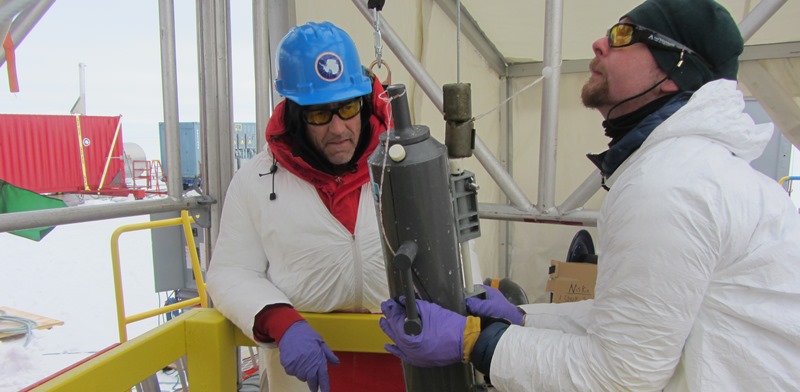Methane-eating bacteria discovered beneath Antarctica

Dr Andrew Mitchell (right) and Professor John Priscu from Montana State University with a water sample brought up from Lake Whillans, which lies 800 metres below the West Antarctic Ice Sheet. Photo: J Mikucki
01 September 2017
Methane-eating bacteria discovered in a lake beneath Antarctica may prevent the powerful greenhouse gas from being release into the atmosphere as ice sheets melt, scientists believe.
Researchers from Aberystwyth University, Louisiana State University and Montana State University have analysed samples of water and sediment retrieved from Lake Whillans which lies 800 metres below the West Antarctic Ice Sheet.
Isolated from direct contact with the atmosphere for many thousands of years, the lake was successfully drilled by the Whillans Ice Stream Subglacial Access Research Drilling (WISSARD) project in 2013.
The team used a combination of measurements of methane concentrations and genomic analyses to describe how lake bacteria chemically convert methane in a way that reduces the warming potential of subglacial gases during ice sheet retreats.
The prevalence of methane-consuming bacteria in the upper lake sediment suggests a "methane bio-filter" prevents the gas from entering the subglacial water, where it can eventually drain into the ocean and be released into the atmosphere.
The bacteria obtain energy from digesting the methane.
Their findings have been published in a paper in the journal Nature Geoscience - Microbial oxidation as a methane sink beneath the West Antarctic Ice Sheet.
Co-author Dr Andrew Mitchell from the Department of Geography & Earth Sciences at Aberystwyth University was a member of the successful 2013 WISSARD mission.
Dr Mitchell said: “We've been aware of microbial methane production in glacial environments and considered the impacts on climate, but this is the first time we have a detailed assessment of methane cycling underneath an ice sheet.”
“Researchers have been concerned with the potential role of this greenhouse could have if released from underneath melting ice sheets.
“The really interesting finding is that while methane production is significant, most of the methane produced, about 99%, is actually oxidised by methanotrophs, which are microbes that live off and use up the methane and produce carbon dioxide in the process”, he added.
Dr Mitchell and his co-authors argue that if their analysis is correct, it could mean that a large reservoir of methane thought to lie under the vast West Antarctic Ice Sheet -- which encompasses 25.4 million cubic kilometers (6.1 million cubic miles) of ice -- is less likely to be released into the atmosphere.
They also note that because methane is such a potent greenhouse gas, "understanding its global sources, sinks and feedbacks within the climate system is of considerable importance" to the scientific understanding of the larger global climate picture.
Their findings describe how biological processes in the sediments at the lake bottom transform the methane into carbon dioxide.
This area, where the water meets the lake bottom, may be vital to the success of ecosystems of subglacial lakes, which are permanently cut off from atmospheric heat and sunlight.
"Not only is this important for the global climate, but methane oxidation could be a widespread means of life for microbes in the deep, permanently cold biosphere beneath the West Antarctic Ice Sheet," said Alexander Michaud of Montana State University, the lead author on the paper.
Studies of subglacial lakes may contain clues as to how microbial life might persist in the outer solar system, where ice-covered moons orbit the larger planets.
In recent decades, researchers, primarily using airborne radar and satellite laser observations, have discovered a continental system of rivers and lakes -- some similar in size to North America's Great Lakes -- beneath the Antarctic ice sheet.
Only a small portion of these lakes have been explored, largely to prevent contamination of a pristine ecosystem that may be interconnected in unknown ways.
WISSARD researchers used a specially designed hot-water drill to make certain that the subglacial environment would remain pristine, and to prevent contamination of samples.
Results presented in the Lake Whillans paper imply that a vast microbial ecosystem capable of transforming key geochemical elements lies beneath the Antarctic ice sheet.
The WISSARD project was preceded by ongoing field research that began as early as 2007 to place this individual lake in context with the larger subglacial water system.
The NSF's U.S. Antarctic Program funded, and provided the complex logistics, for those investigations and the sampling of Lake Whillans.
"It took more than a decade of scientific and logistical planning to collect the first clean samples from an Antarctic subglacial environment, but the results have transformed the way we view the Antarctic continent," said John Priscu of Montana State University, a co-author on the paper.



